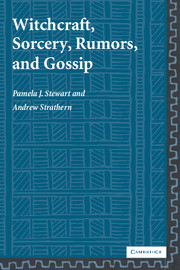8 - Conclusions: Conflict and Cohesion
Published online by Cambridge University Press: 20 November 2009
Summary
As we explained in the Introduction to this book, our intention has been to bring together the discussion of rumors and gossip with materials on witchcraft and sorcery. At the most straightforward level, the aim has been to show that rumors and gossip play an important part in the overall processes that lead to witchcraft accusations. Starting from events that precipitate dislike between individual neighbors or kin, inchoate suspicions and suggestions may develop over time into judicial actions in which the particular dispute may come to be seen as a part of a struggle for social order, conceptualized in terms of good versus evil forces. In this phase the forces of evil may be seen as engaged in a conspiracy against the good. Violent actions in defense of “the good” then come to be seen as justifiable. The judicial executions and the mob killings that eventuate are seen by their perpetrators as ways of ridding the society of evil and of achieving a new balance in the cosmos, with tinges of millenarian desires and apocalyptic ideas entering people's consciousness. Political leaders and witch-finders may benefit from this process by increasing their power and/or their wealth. Individuals who feed accusations into a charged political or judicial context also may stand to gain in one way or another, most generally by ridding themselves of guilt and anxiety regarding the state of affairs in the world and their own actions within it.
- Type
- Chapter
- Information
- Witchcraft, Sorcery, Rumors and Gossip , pp. 194 - 204Publisher: Cambridge University PressPrint publication year: 2003



